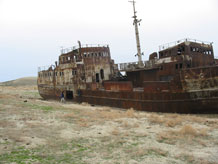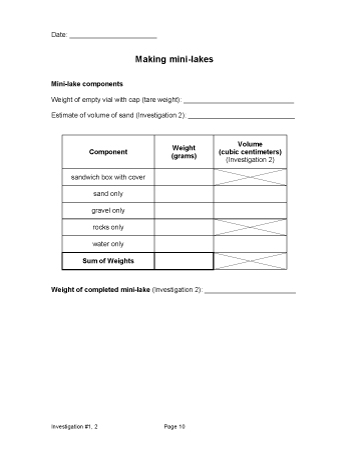Why are these ships in a field?
Plan Investigation 1

Staecker, via Wikimedia Commons
Why are these ships in a field? Part of the answer is evaporation, but how could evaporation happen at this scale? And where is all that water now? The investigations students encounter over the next few weeks shed light on this mystery. By the end of the unit, they know the full story behind the ships in the field.
This unit investigates transformations of water over time and we begin with the example of a lake. It's not practical to study an actual lake, but what if we could we simplify and shrink things down to the size of a sandwich box? Could a simplified version of a lake help us understand some important processes that occur within larger bodies of water? Students begin building their own mini–lakes, but do not complete them until the next science class. As they build, they keep track of the amount of material in their lake. This “accounting” provides a way to study how and why materials change. Students will continue to observe their mini–lakes throughout the unit. Find a good place in your classroom to keep the collection of lakes — your class's own Lake District!
By the end of this investigation students will understand how to weigh the amount of each material in their mini–lake.
Learning Goals
- Understand that the classroom mini–lakes will help students understand the processes that occur in real lakes
- Measuring and recording weight is a way to keep track of materials
| Sequence of experiences | ||
|---|---|---|
| 1. Introduce the unit | All Class | 5 Mins |
| 2. Elicit ideas | All Class | 10 Mins |
| 3. Introduce the mini-lakes | All Class | 5 Mins |
| 4. Weigh materials | Pairs | 25 Mins |
Materials and Preparation
Preparation:
- Read Why are these ships in a field? (See Resource Quick Links)
- Science Notebook for each student
- Prepare 12 index cards, 3 labeled “120 grams”; 3 labeled “130 grams”; 3 labeled “140 grams” and 3 labeled “150 grams”
For the class:
- Post the investigation question in a place where all students can see it.
- Set of images of "ships in a field" (pdf or ppt formats) or notebook pages[pdf].
- Computer and a system for projecting the images if using electronic presentation.
- Prepare a sample mini–lake. Use 120g of sand and 120g of gravel to prepare a small lake bottom and shoreline in a sandwich box. Add 120g of water and a few small rocks around the perimeter of the shoreline.
- Have one set of materials available for use during the introduction.
For each group:
(Each group assumes 4 students. You may need to adjust the groups to suit your class size and configuration.)

- 1 6in strip of masking tape
- 2 index cards, as prepared above
- 2 plastic spoons
- 2 sandwich boxes with covers
- 2 12oz cups 2/3 full of sand
- 2 12oz cups 2/3 full of gravel
- 2 12oz cups 2/3 full of water
- 2 12oz cups each holding 8 small rocks
- 8 plastic vials with covers
- 1 digital scale; Number and assign each scale to a group for use throughout the curriculum. This will help students get consistent results in the event of small differences between scales.
Note: Students weigh the sandwich boxes and covers in this investigation. They do not assemble mini-lakes until the next investigation.





